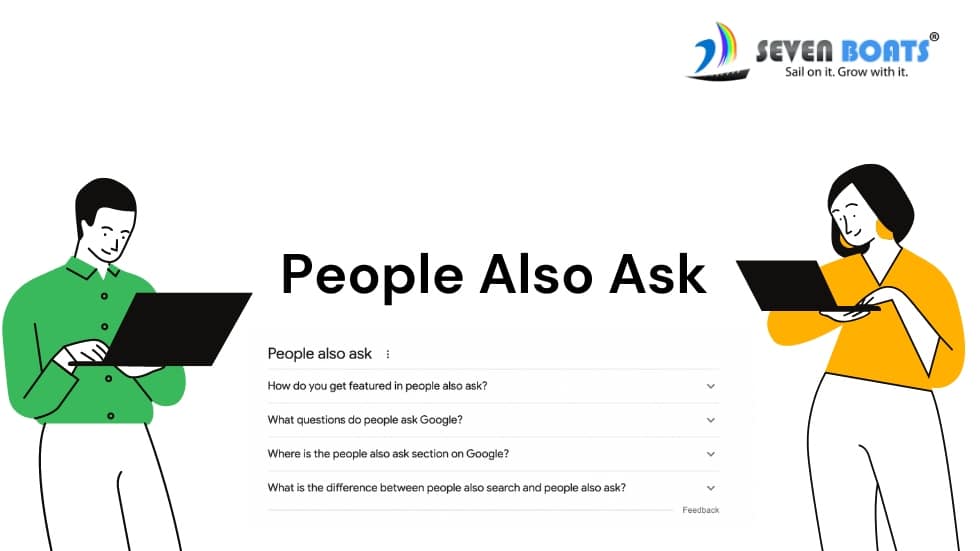What is Google’s ‘People Also Ask’?
People also ask (PAA) is a Google search feature that displays a list of questions related to the user’s query. PAA is designed to help users find information more easily by providing them with a list of relevant questions that other users have asked about the same topic.
The world of SEO has changed considerably in the last few years. New features have sprung up to help searchers. But many of these features have left SEO experts a little confused initially!
It is only after studying the new features carefully and through thorough experimentation, SEO pundits have worked their way to optimize the new features. You can say this about Google and the work they do that they work for the benefit of everyone who is a stakeholder in this equation: the searcher and the average SEO professional.

In this context, one feature that has dramatically changed the space above the fold in Google searches (SERP) is a series of questions which try to answer your initial query by proposing other similar questions.
By clicking on the drop-down arrow beside the question, you get a quick glimpse of the answer, followed by a URL of the answer’s source. If you want to take a closer look at the answer, you can click and go to that page.
This feature is titled ‘People Also Ask’. The question to ask is, how has this feature changed the face of SEO? Are they stealing away clicks which would have gone to websites that are ranked higher?
This question is even more pertinent in the case of mobile searches because space on the mobile phone screen is very vital for SEO professionals. In this post, we are looking at some of the implications of this new ‘People Also Ask’ or PAA feature.
The “People Also Ask” (PAA) feature is a box that appears on Google’s search engine results pages (SERPs). It is populated with questions related to the user’s query, based on Google’s understanding of the topic. PAA boxes can appear above the regular search results, or they may be interspersed throughout the SERP. ranking for PAA is similar to ranking for regular search results.
The primary difference is that PAA boxes are generated algorithmically, based on Google’s understanding of the topic, rather than being determined by human editors. As a result, it can be difficult to know which questions will appear in a PAA box ahead of time.
However, there are a few things that you can do to improve your chances of appearing:
- first, make sure that your website contains high-quality content that thoroughly covers the topic at hand;
- second, use structured data markup to explicitly indicate the question-answer pairs on your pages; and
- third, ensure that your site ranks well for relevant queries.
By taking these steps, you can improve your chances of appearing in PAA boxes and drive more traffic to your site.
Features of “People Also Ask” Section
Location No Bar
The first pointer to understand about People Also Ask (PAA) is that their location is not always specific. Sometimes they appear at the very top while at other times, they may be located a little further downwards.
The location is crucial because clicks depend on where a particular content is located. Sometimes, they are below paid ads, sometimes even below the 10 organic SERP listings.
Videos No Bar
You should know that People Also Ask is not only about questions and their answers. Sometimes video links also form part of the PAA. However, right now this feature is not available globally. Probably Google has rolled out video links in PAA only for USA.
If you have a video content marketing team and use YouTube regularly for disseminating content, you should work on optimizing the videos to feature in People Also Ask. For questions that demand a video answer, like ‘How to’ questions, your videos will do better than just text answers.
Limit No Bar
If you are concerned about the number of PAA questions that can be triggered against a particular query, you should rest assured that there is no such limit. Moreover, the whole People Also Ask list is quite dynamic in the sense that once you click on a particular question to read the answer, it can trigger an avalanche of several other questions which were not originally there.
In other words, your initial query may trigger 3 or 4 People Also Ask questions but the moment you read one, another 5 may pop up. So the limit varies and you cannot put a number on it. Yet. So, you can work on several questions to address a matter. It will give you more opportunity to grab the searcher.
How to rank in the “People Also Ask” section of Google Search
To rank in the “People Also Ask” section of Google Search, you can follow these strategies:
- Choose Relevant Topics: Carefully select topics that are relevant to your target audience and align with their search intent.
- Optimize Content: Create high-quality, informative content that includes questions and answers related to the chosen topic. Ensure that your content provides value and addresses user queries comprehensively.
- Use Long-Tail Keywords: Focus on long-tail keywords that are specific and less competitive. These keywords are more likely to match the queries that trigger the “People Also Ask” section.
- Structure Content for Readability: Format your content in an easily scannable and digestible manner. Use headings, bullet points, and concise paragraphs to enhance readability.
- Provide Credible Information: Establish credibility by citing reputable sources, linking to authoritative websites, or referencing expert opinions. This helps build trust with both users and search engines.
- Research Common Questions: Identify popular questions related to your topic by researching the “People Also Ask” section and other sources outside of Google. Incorporate these questions and their answers into your content.
- Monitor Performance: Use tools like Google Search Console to track how your content performs in the “People Also Ask” section. Analyze the data to identify opportunities for improvement and optimize your strategy accordingly.
Remember, ranking in the “People Also Ask” section requires a combination of relevant content, strategic optimization, and providing value to users. Continuously monitor and refine your approach to increase your chances of appearing in this prominent section of Google Search.
Summary
To rank for PAA, you need to ensure that your content is relevant to the user’s query and that it contains the keywords that people are likely to use when asking questions about the topic. In addition, you need to make sure that your website is well-optimized for search engines so that your content appears in the top results for the user’s query.
Hope these pointers help you make better SEO with the People Also Ask feature!








0 Comments